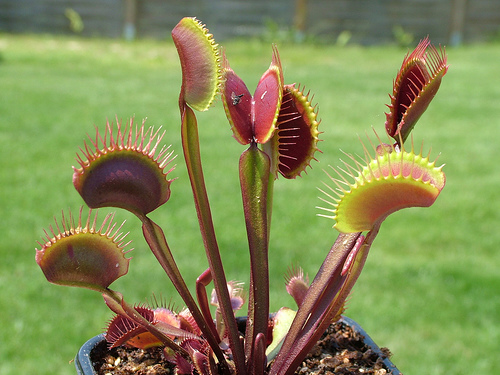|
This tender, insectivorous perennial is popularly known as the Venus Flytrap. It grows up to 4 inches high and spreads up to a foot. The Venus Flytrap is found wild in the bogs of North and South Carolina. D. muscipula has evergreen, 2-lobed leaves, which are hinged at the midrib. They are stained pink with touch-sensitive bristles inside and edged with long, stiff bristles. When an insect lands in the leaves, the lobes close together tightly. The insects are then dissolved by the digestive fluid secreted by leaf glands. Eventually, the lobes open again in readiness for more prey. The small, 5-petaled, white flowers are borne in bunches of 3 to 10 in the summer.
Pot Cultivation
In cool climates, this plant should be grown in a house or greenhouse, in containers filled with vermiculite, peat and sphagnum moss. Set the pots in saucers filled with about �-inch of soft water. Once they are potted they shouldn't be disturbed. Protect from rain and overhead watering. They need 6 to 8 hours of sunlight a day. If you feed your plant, give it only very small, soft-bodied insects such as spiders or ants. Larger insects will kill your plant. Do not feet it hamburger, boiled egg, etc. Once a leaf trap has closed, it takes several days for it to reopen; "teasing" the plant into closing its leaves can deprive it of normal feeding.
Propagation
Seeds may be sown thinly in a flat or pot filled with one part vermiculite and one part peat. Don't cover them and place in a shallow tray of water in a warm, sheltered location that receives indirect light. They will usually sprout within 30 days. After they've appeared, gradually expose to more sun. Venus Flytraps may also be divided in the spring.
 |
| D. muscipula. |
Varieties D. muscipula. |